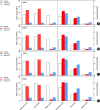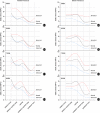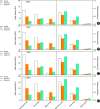Intra-Articular Biomechanical Changes of the Meniscus and Ligaments During Stance Phase of Gait Circle after Different Anterior Cruciate Ligament Reconstruction Surgical Procedures: A Finite Element Analysis
- PMID: 36222205
- PMCID: PMC9732611
- DOI: 10.1111/os.13516
Intra-Articular Biomechanical Changes of the Meniscus and Ligaments During Stance Phase of Gait Circle after Different Anterior Cruciate Ligament Reconstruction Surgical Procedures: A Finite Element Analysis
Abstract
Objective: The debate on the superiority of single- or double-bundle for anterior cruciate ligament reconstruction has not ceased. The comparative studies on intra-articular biomechanics after different surgical reconstructions are rare. This study is to evaluate the biomechanical stress distribution intra-knee after single- and double-bundle anterior cruciate ligament reconstruction by three-dimensional finite element analysis, and to observe the change of stress concentration under the condition of vertical gradient loads.
Methods: In this study, magnetic resonance imaging data were extracted from patients and healthy controls for biomechanical analysis. Patients included in the three models were matched in age and sex. The strength and distribution of induced stresses were analyzed in two frequently used procedures, anatomical single-bundle anterior cruciate ligament reconstruction and anatomical double-bundle anterior cruciate ligament reconstruction, using femoral-graft-tibial system under different loads, to mimic a post-operation mechanical motion. The three-dimensional finite-element models for normal ligament and two surgical methods were applied. A vertical force simulating daily walking was performed on the models to assess the interfacial stresses and displacements of intra-articular tissues and ligaments. The evaluation results mainly included the stress of each part of ligament and meniscus. The stress values of different parts of three models were extracted and compared.
Results: The stress of ligament/graft at femoral side of three finite-element models was significantly higher than at tibial side, while the highest level was observed in single-bundle reconstruction finite-element model. With the increase of force, the maximum stress in the medial (7.1-7.1 MPa) and lateral (4.9-7.4 MPa) meniscus of single-bundle reconstruction finite-element model shifted from the anterior horn to the central area (p = 0.0161, 0.0479, respectively). The stress was shown to be at a lower level at femoral side and posterior cruciate ligament of intra-knee in two reconstruction finite-element models than that in normal finite-element models, while presented higher level at the tibial side than normal knee (p = 0.3528). The displacement of the femoral side and intra-knee areas in reconstruction finite-element models was greater than that in normal finite-element model (p = 0.0855).
Conclusion: Compared with the single-bundle technique, the graft of double-bundle anterior cruciate ligament reconstruction has better stress dissipation effect and can prevent postoperative meniscus tear more effectively.
Keywords: Anterior cruciate ligament; Displacement; Double bundle; Finite-element model; Intra-knee; Single bundle; Stress.
© 2022 The Authors. Orthopaedic Surgery published by Tianjin Hospital and John Wiley & Sons Australia, Ltd.
Conflict of interest statement
The authors declare that they have no conflicts of interest for this paper.
Figures




Similar articles
-
Comparison of the biomechanical properties of grafts in three anterior cruciate ligament reconstruction techniques based on three-dimensional finite element analysis.J Orthop Surg Res. 2024 May 29;19(1):322. doi: 10.1186/s13018-024-04777-x. J Orthop Surg Res. 2024. PMID: 38812053 Free PMC article.
-
[Anatomical and finite element analysis of anterior cruciate ligament reconstruction within biomechanical insertion].Beijing Da Xue Xue Bao Yi Xue Ban. 2019 Jun 18;51(3):586-590. doi: 10.19723/j.issn.1671-167X.2019.03.031. Beijing Da Xue Xue Bao Yi Xue Ban. 2019. PMID: 31209435 Free PMC article. Chinese.
-
[Finite element analysis of the graft stresses after anterior cruciate ligament reconstruction].Beijing Da Xue Xue Bao Yi Xue Ban. 2021 Oct 18;53(5):865-870. doi: 10.19723/j.issn.1671-167X.2021.05.009. Beijing Da Xue Xue Bao Yi Xue Ban. 2021. PMID: 34650286 Free PMC article. Chinese.
-
Biomechanical characteristics of ligament injuries in the knee joint during impact in the upright position: a finite element analysis.J Orthop Surg Res. 2024 Oct 7;19(1):630. doi: 10.1186/s13018-024-05064-5. J Orthop Surg Res. 2024. PMID: 39375697 Free PMC article.
-
Anatomic single- and double-bundle anterior cruciate ligament reconstruction, part 1: Basic science.Am J Sports Med. 2011 Aug;39(8):1789-99. doi: 10.1177/0363546511402659. Epub 2011 May 19. Am J Sports Med. 2011. PMID: 21596902 Review.
Cited by
-
Over-the-Top Double-Bundle Revision Anterior Cruciate Ligament Reconstruction Technique With Hybrid Hamstring Tendon Autograft-Allograft and Associated Lateral Extra-articular Tenodesis.Arthrosc Tech. 2024 Mar 22;13(5):102944. doi: 10.1016/j.eats.2024.102944. eCollection 2024 May. Arthrosc Tech. 2024. PMID: 38835449 Free PMC article.
References
-
- Louboutin H, Debarge R, Richou J, Selmi TA, Donell ST, Neyret P, et al. Osteoarthritis in patients with anterior cruciate ligament rupture: a review of risk factors. Knee. 2009;16:239–44. - PubMed
-
- Bicer EK, Lustig S, Servien E, Selmi TA, Neyret P. Current knowledge in the anatomy of the human anterior cruciate ligament. Knee Surg Sports Traumatol Arthrosc. 2010;18:1075–84. - PubMed
-
- Aga C, Risberg MA, Fagerland MW, Johansen S, Troan I, Heir S, et al. No difference in the KOOS quality of life subscore between anatomic double‐bundle and anatomic single‐bundle anterior cruciate ligament reconstruction of the knee: a prospective randomized controlled trial with 2 years' follow‐up. Am J Sports Med. 2018;46:2341–54. - PubMed
MeSH terms
Grants and funding
- XMLX202137/Beijing Hospital Authority
- 202022082/Capital Health Research and Development of Special Fund
- XJDX17112115/Key Laboratory of Autonomous Region XinJiang Key Laboratory Neurological Disorder Research
- 2016YFC1103202/National Key Research and Development Program
- 11772038/National Natural Scientific Foundation of China
LinkOut - more resources
Full Text Sources
Medical

